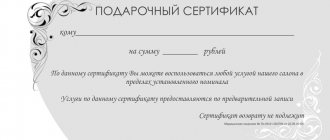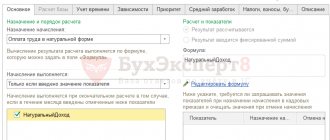Accounting
The procedure for recording sales of goods to employees in accounting depends on:
- type of property being sold (purchased goods, fixed assets, etc.);
- payment method (cash or salary deduction).
If an organization transfers purchased goods or finished products to an employee, write off their value as follows:
Debit 90-2 Credit 41 (43)
- the purchase price of goods sold (cost of finished products) is written off.
If an organization sells other property to an employee, write them off the register as follows:
Debit 91-2 Credit 01 (08, 10, 21...)
- the cost of fixed assets (unfinished construction projects, materials, semi-finished products, etc.) has been written off.
This procedure follows from the Instructions for the chart of accounts (accounts 90-2, 91-2).
Calculation of salary taxes and contributions: accounting features
Immediately after payroll is calculated:
- Personal income tax.
The fact of calculation and withholding of personal income tax is reflected in the accounting registers by posting: Dt 70 Kt 68.
If a personal income tax deduction is applied to wages, then it does not need to be reflected in accounting.
- Insurance premiums.
The fact of their accrual is reflected by the posting: Dt 20 Kt 69. As in the case of salary postings, correspondence can also be generated by debits of such accounts as 23, 25, 26, 29, 44 and others discussed above.
The accrual of personal income tax and contributions is shown, like the accrual of wages, on the last day of the month.
Personal income tax and contributions are calculated on the total amount of salary without any adjustment for the advance payment.
ATTENTION! From November 30, 2020, the cashier is not required to require a passport from the recipient of funds to identify him.
When the salary is issued, the postings will be as follows.
Cash sales
If an employee pays for goods in cash, reflect the receipt of money in the cash register on account 50 “Cash desk” (Instructions for the chart of accounts).
If purchased goods or finished products are sold to an employee, accrue the proceeds from the sale (clause 5 of PBU 9/99):
Debit 50 Credit 90-1
- revenue from the sale of purchased goods or finished products is reflected.
If the employee acquired other property of the organization, accrue other income (clause 7 of PBU 9/99):
Debit 50 Credit 91-1
– reflects other income from the sale of fixed assets (unfinished construction projects, materials, semi-finished products, etc.).
An example of how to reflect in accounting the sale of goods to an employee for cash
On March 19, Torgovaya LLC sold to storekeeper P.A. Bespalov iron. On the same day, Bespalov paid the cost of the iron to the cash register.
The selling price of the iron is 826 rubles. (including VAT - 126 rubles). The purchase price of the goods is 590 rubles. (including VAT - 90 rubles). The organization records goods at purchase price.
The Hermes accountant made the following entries on March 19:
Debit 50 Credit 90-1
- 826 rub. – revenue received from the sale of goods to an employee is reflected;
Debit 90-2 Credit 41
- 500 rub. (590 rubles – 90 rubles) – the cost of the goods transferred to the employee is written off;
Debit 90-3 Credit 68 subaccount “VAT calculations”
- 126 rub. – VAT is charged to the budget.
Checking remaining materials
The decision to sell materials from the enterprise's warehouses, as a rule, is made after taking inventory or generating a control report on the balances of inventories.
Their accounting is kept on accounting account 10 “Materials” and is organized with the obligatory indication of analytics by type, storage location (warehouses) and documents of receipt of materials and materials in the organization. Quantitative and total records are kept on the account.
To obtain balances of materials, you can use a typical standard accounting report - “Account balance sheet”. Standard reports are available from the section of the main system interface of the same name.
Fig. 1 Account balance sheet
Let's set the report settings for account 10 with grouping by subaccounts, warehouses and materials:
Fig.2 Account report settings 10
The result of the generation will be a report in the following format:
Fig.3 Report appearance
As of the report, we have significant balances of materials in subaccount 10.01, which are located in the main warehouse of the enterprise.
Deduction from salary
If the purchase price is deducted from an employee’s salary, make payments to him on account 73 “Settlements with personnel for other operations” (Instructions for the chart of accounts):
Debit 73 Credit 90-1 (91-1)
- revenue from the sale of goods, finished products (other property) to an employee is reflected;
Debit 70 Credit 73
- The cost of goods sold to an employee is deducted from the salary.
If the organization is a VAT payer, when selling goods the employee must be charged this tax (Clause 1, Article 39 of the Tax Code of the Russian Federation). Make the following entry in accounting:
Debit 90-3 (91-2) Credit 68 subaccount “VAT calculations”
- VAT has been charged.
An example of how to reflect in accounting the sale of goods to an employee with deduction of its cost from the salary
On June 22, Torgovaya LLC sold to storekeeper P.A. Bespalov iron. Bespalov wrote a statement asking for the cost of the iron to be withheld from his salary.
The selling price of the iron is 826 rubles. (including VAT - 126 rubles). The purchase price of the goods is 590 rubles. (including VAT - 90 rubles). The organization records goods at purchase price.
The Hermes accountant made the following entries.
22nd of June:
Debit 73 Credit 90-1
- 826 rub. – revenue from the sale of goods to an employee is reflected;
Debit 90-2 Credit 41
- 500 rub. (590 rubles – 90 rubles) – the cost of the goods transferred to the employee is written off;
Debit 90-3 Credit 68 subaccount “VAT calculations”
- 126 rub. – VAT is charged to the budget based on the invoice.
30 June:
Debit 70 Credit 73
- 826 rub. – the cost of goods sold to an employee was deducted from his salary for June.
Features of issuing wages “in kind”
Often, due to a lack of money, firms pay workers in products. Any accountant and tax inspector knows what taxes need to be paid on it. Or he thinks he knows.
N. Rudenkova, Ph.D. Sc., expert editor of the berator “Practical Accounting” The Labor Code allows employees to be paid wages not only in money, but also “in kind” (Article 131). These can be either the company’s own products or purchased goods, works or services. Since payment in kind is part of the total salary, it is subject to unified social tax, pension contributions and contributions for insurance against industrial accidents and occupational diseases. Personal income tax is withheld from the value of transferred assets (work, services). Moreover, it is calculated from the market value of goods (Article 211 of the Tax Code of the Russian Federation), but not lower than their actual cost.






